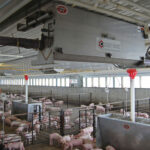Conditioning Tips for Superior Hay Quality
Done at its best, hay conditioning can shave two to five days off drying time, helping maintain harvest cycles and ensuring top-quality hay. Producing consistent, top-quality hay requires tight management of harvest schedules to get hay cut at the proper time,...
Conditioning Tips for Superior Hay Quality
Done at its best, hay conditioning can shave two to five days off drying time, helping maintain harvest cycles and ensuring top-quality hay. Producing consistent, top-quality hay requires tight management of harvest schedules to get hay cut at the proper time,...Done at its best, hay conditioning can shave two to five days off drying time, helping maintain harvest cycles and ensuring top-quality hay.
Producing consistent, top-quality hay requires tight management of harvest schedules to get hay cut at the proper time, then dried, baled and moved off the field quickly so the next cycle can begin.
Proper hay conditioning is a key element in meeting crop cycle objectives, says Dean Morrell, AGCO product marketing manager for Hesston by Massey Ferguson hay products and a 35-year-veteran of the quality-hay business. “If you don’t condition the crop, and condition it well, staying on a 28- to 32-day hay harvest cycle can be tough,” he says. “Conditioning can save two to five days in drying time, so it is a crucial aspect of keeping on schedule.” Keep in mind, hay plants at 80 percent moisture must lose about 6,000 lbs. per acre of water to produce a ton of hay at 20 percent moisture. Conditioning crimps the stem, opening up the waxy cuticle layer of the stem, letting the plant moisture evaporate faster.
Operators’ manuals provide full details on how to adjust and run specific conditioners. Here are tips from Morrell that outline four important steps in achieving superior conditioning results, no matter what the model:
- Set the conditioner roll gap at 1/16 inch or less, which creates noticeable breakage of the stem skin to speed stem drying. Setting the gap too tight crushes leaves, increasing loss of critical nutrients. “Setting the roll gap is the most crucial adjustment of the conditioner,” says Morrell.
- Set roll tension tight enough to achieve a consistent roll gap. If the crop is being over-conditioned, such as with less mature crops, loosen the roll gap tension. Reducing tension also can help solve plugging challenges. In addition, be sure to check that the rolls have not worn more in the center than the ends. Replace worn rolls, since consistent roll condition and diameter are vital to maintain uniform pressure and consistent results for even crop drying.
- The third critical conditioning element is laying out an even windrow that is as flat and wide as possible without lumps, ridges or clumps of crop. This reduces drying time for better leaf retention and faster, more consistent harvest cycle time. For the widest possible windrow, set the swath board all the way down (at its lowest/flattest possible position).
- It’s also critical to keep up to date on regular maintenance to ensure peak machine performance. Be sure to visit your local dealer to stock up on knives, cutterbar teeth, guards, ledger plates, common bearings, belts and other common repairs before the hay season starts, to minimize downtime from common breakdowns. Dealers often have a list of recommended parts for on-farm stocking and may offer preseason discounts for parts purchases.




